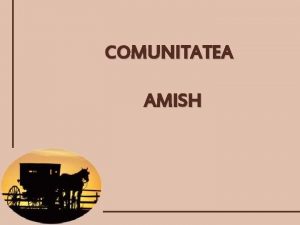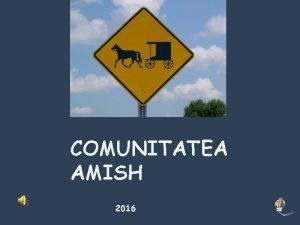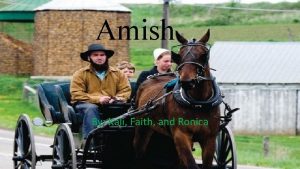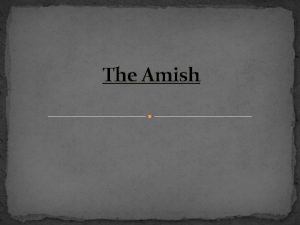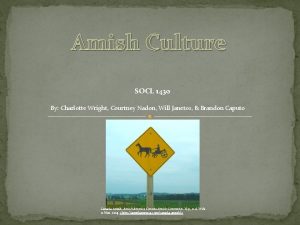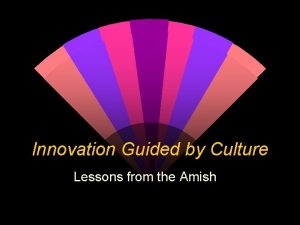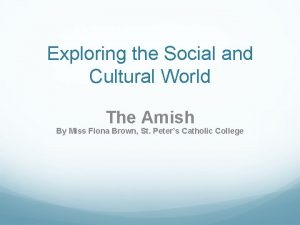The Amish Culture Introduction As a human service























- Slides: 23

The Amish Culture

Introduction As a human service professional I am sure I will come across many different cultures, but the one that intrigues me the most is the Amish. This culture shies away from modern society, and it is hard to believe that anyone would want to live in s primitive lifestyle. Subsequently the majority of modern society cannot relate to them. This will lead into intercultural communication barriers. However if we learn their customs and cultural dimensions we will get a better understanding of their nature. So in this Power. Point presentation I will explain the Amish culture and their way of life for a better understanding of this unique culture.

Overview • • • Amish History/Know Facts Separation from Modern Society Different dimensions in this culture Diversity amongst the Amish Cultural Relativism Conclusion

Amish History • According to Center for Health Disparities (n. d), “the Amish are one of the oldest and most unique minority populations in the United States. ” • According to Jandt (2010), the Amish migrated from Switzerland in 1720’s to Pennsylvania (p. 325). They broke away from the Mennonites, which means “ plain people”, because Mennonites began taking a liberal view of those who had been excommunicated (p. 325).

Amish History • They are a homogenous culture, so they are taught to be plain; humble in their homes, clothing, carriages, and everything else they own (Kraybill, 1998).

Amish History • The Amish practice a traditional form of Christian fundamentalism that has changed little upon settlement to the United States. “Humility, obedience, simplicity, sharing, and community are valued” (Jandt, 2010, p. 325) • They believe in total submission to God. The “Ordnung” contains the church rules and outlines the values of the community (p. 325). Their whole life is dedicated to the Lord, and with that, they have a ridged political structure and very strong family values (Cong, 1994).

Separation from Modern Society • The laws are written by church councils, then passed down to the individual communities. The communities discuss the laws written, and once agreed upon, then the Amish communion together (Holmes & Block, 2013). • “They are well-known for their preference to remain apart, from mainstream American society so that they may practice their traditional lifestyles” (Center for Health Disparities, n. d).

Separation from Modern Society • In practicing simplicity and following a strict religious life, they forbid the internet and some technology. They believe if the internet is allowed, the Amish community will have access to the values of contemporary culture; which is contrary to their own. • So, they do not want mass media to spoil their religious beliefs. thus destroying their way of life. The Amish want to ensure their cultural traditions and values are upheld and maintained.

Separation from Modern Society • Kraybill, (1998) quoted one of the Amish guide as saying, “how many minds have been damaged and polluted by the diet of romance and violence from these media? ” “Forsaking these is one of the first and most important steps for anyone” (p. 105).

Separation from Society • They are however, open to new technology that would improve upon their welfare of the community, and it fits into the regulations of the group. They are willing to make some adaptions to enable them to prosper economically (Kraybill, 1998). • The Amish have to struggle to remain separate from the world (Tharp, 2007). Tharp (2007) explained that the “Ordnung is constantly being negotiated to regulate both demands from outside governmental mandates and the expanding desires of church members” (p. 41).

Separation From Modern Society (Click on phot to play video) https: //www. youtube. com/watch? v=q. Xmrx. Wmb. HCU

Dimensions in Culture • There is an individualism versus collectivism way of thinking in every culture. The Amish are definitely a collective community. The interest of this group prevails over those of the individuals (Jandt, 2010).

Dimensions in Culture • The Amish have other dimensions to their culture. The first being power distance: meaning “distribution of influence within a culture” (Jandt, 2010). They are taught from a early age, that children are expected to be obedient towards their parents and elders. The women are also expected to respect the final choices of men. • Uncertainty avoidance is another dimension. This “reflects a culture’s tolerance of ambiguity and acceptance of risk” (Jandt, 2010). There is a strong need for written and unwritten rules in the Amish culture; hence the Ordnung was be developed to set the rules and standards (Jandt, 2010).

Diversity amongst the Amish • Technology is condoned, unless it is beneficial to the community. However, this can bring about a division amongst some in the Amish community, causing others to branch off and start their own group (Jandt, 2010). • There are three types of Amish people: The Old Order, New Order, and the Beachy Amish (Jandt, 2010).

Diversity amongst the Amish According to Jandt, 2010, the different types of Amish groups are as follows: • The Old Order Amish are those that avoid any use of electricity and cars (p. 326). • The New Order Amish are those that use telephones and powered farm equipment, but the tool has to use batteries and generators rather than electricity (p. 326). • The Beachy Amish are those that use telephones and electricity (p. 326).

Diversity amongst the Amish • Below is pictures of the New and Beachy Amish group

Diversity amongst the Amish • Despite the diversity amongst the Amish, their main way of travel is still horse and carriage.

The Amish Culture (Click on photo to play video) https: //www. youtube. com/watch? v=_Ce. T 32 qx. UK 0

Cultural Relativism • Cultural relativism is a belief that different cultures are worthy in their own right. So society should not pass judgment on another society. • The Amish have learned to deal with the outside community. So in order to successfully negotiate with the secular community, the Amish had to improve the intercultural communication skills. They started their own "Amish arbitration" process. It is a panel of elders of Amish men that would help with resolution of any type of conflict with their own and modern society (Miller, 2007).

Cultural Relativism • Culture is how others live, where they originate from, and their religious beliefs (Jandt, 2010). In order to properly provide for a particular culture, one has to know their “clients. ” Unfortunately, the majority of us tend to stereotype and show ethnocentrism. • Preservation of one’s culture, should not be looked down upon or ridiculed. Even though the Amish are very different then most groups, we could learn a lot from them, thus creating a harmonious society.

Conclusion In order to have effective intercultural communication with the Amish people as human service professional we must also: • Get to know their language, customs and traditions • Acknowledge and respect each others cultural differences. • Be self-aware of one’s own personal cultural identity • Show resourcefulness in handling different situations. • Develop a positive communication climate

References • Center for Health Disparities (n. d. ). The Amish. Project Export. University of Northern Iowa. Retrieved from: http: //www. iowahealthdisparities. org/documents/amish. pdf • Cong, D. (1994). The roots of Amish popularity in contemporary U. S. A. Journal of American Culture (01911813), 17(1), 59 • Folkstreamer (2009). The Amish: A People of Preservation. Retrieved from: https: //www. youtube. com/watch? v=q. Xmrx. Wmb. HCU • Geobeats (2014). Ten little know facts about the Amish. Retrieved from: https: //www. youtube. com/watch? v=_Ce. T 32 qx. UK 0 • Holmes, D. , & Block, W. E. (2013). Amish in the 21 st Century. Religion & Theology, 20(3/4), 371 -383. doi: 10. 1163/15743012 -12341269

References • Jandt, E. F. (2010). Dimensions of Culture. An Introduction to Intercultural Communication: Identities in a Global Community. (6 th Ed. ) Thousand Oakes, CA: Sage • Kraybill, D. B. (1998). Plain reservations: Amish and Mennonite views of media and computers. Journal Of Mass Media Ethics, 13(2), 99. • Miller, W. a. (2007). Negotiating with Modernity: Amish Dispute Resolution. Ohio State Journal On Dispute Resolution, 22(2), 477526 • Tharp, B. M. (2007). Valued Amish Possessions: Expanding Material Culture and Consumption. Journal Of American Culture, 30(1), 38 -53. doi: 10. 1111/j. 1542 -734 X. 2007. 00463. x • Cultural Relativism (n. d. ) Retrieved from: https: //www. princeton. edu/~achaney/tmve/wiki 100 k/docs/Cultural _relativism. html
 Amish folk culture
Amish folk culture Amish people beliefs
Amish people beliefs Directional selection example
Directional selection example Amish origini
Amish origini Amish casatorie
Amish casatorie Amish clothing history
Amish clothing history Weird amish names
Weird amish names Jennifer holzhauser
Jennifer holzhauser Christian denomination comparison chart
Christian denomination comparison chart Amish catholic
Amish catholic Inbreeding in humans
Inbreeding in humans Comunitatea amish
Comunitatea amish What is cultural divergence
What is cultural divergence Individual culture traits combine to form culture patterns.
Individual culture traits combine to form culture patterns. Batch culture vs continuous culture
Batch culture vs continuous culture Continuous culture and batch culture
Continuous culture and batch culture Collectivistic cultures
Collectivistic cultures Difference between american and indian culture
Difference between american and indian culture Stab culture and stroke culture
Stab culture and stroke culture Folk culture and popular culture venn diagram
Folk culture and popular culture venn diagram Subculture group
Subculture group What is folk culture
What is folk culture Site:slidetodoc.com
Site:slidetodoc.com Homework due today
Homework due today



